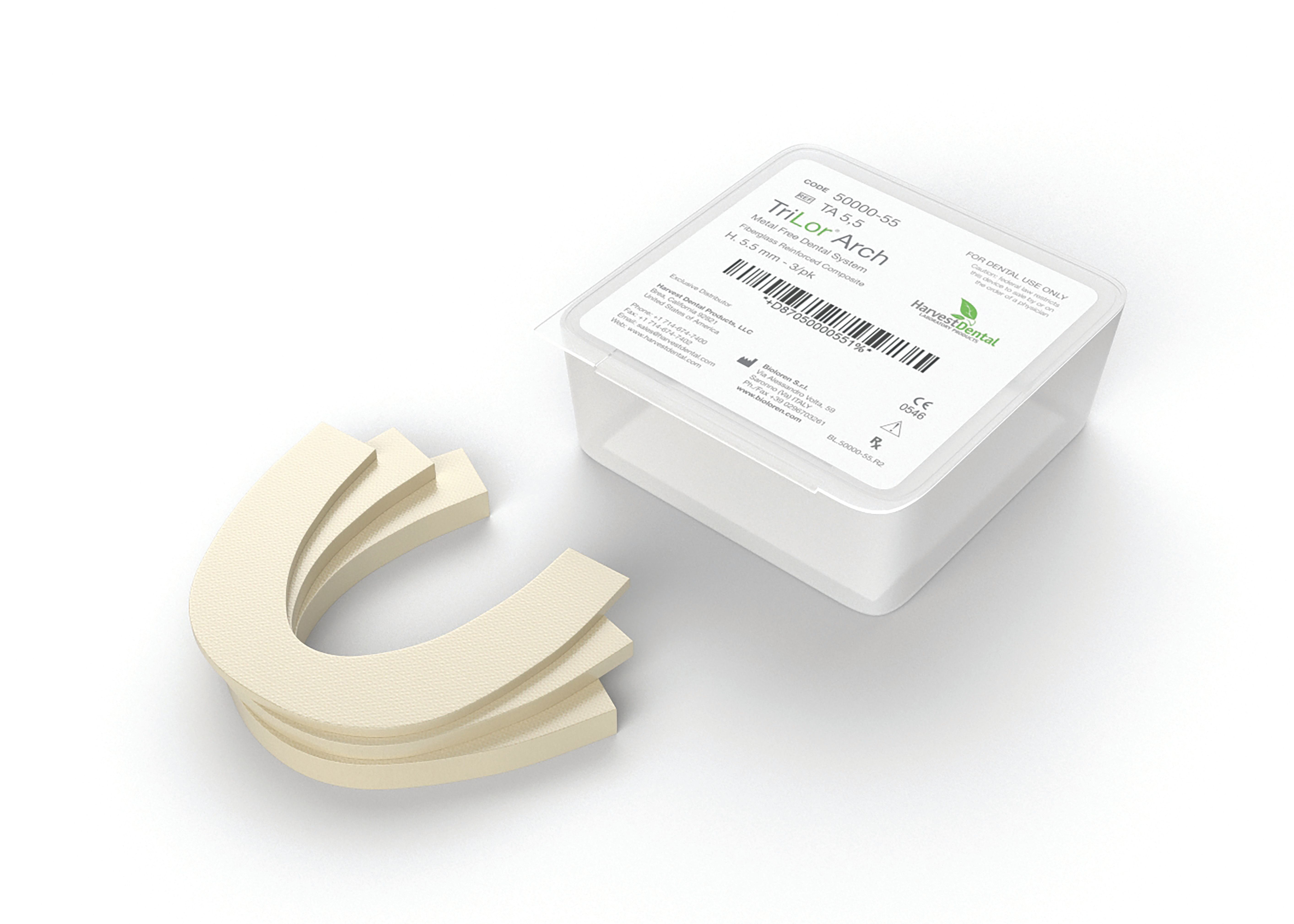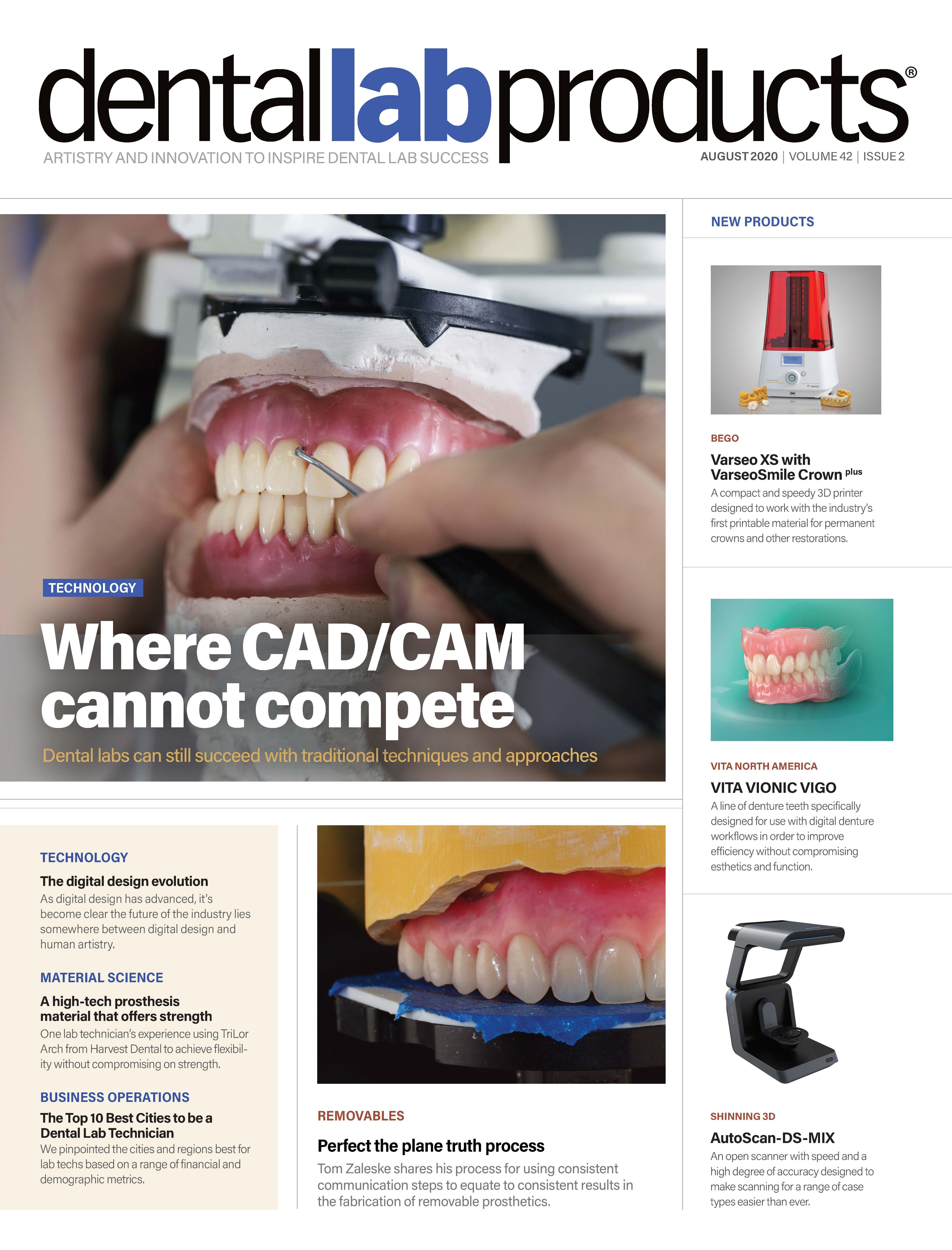A dental technician at Guided Dental Ceramics, LLC in Naples, Florida, Jason Dunbar specializes in Chrome Guided Surgery for all-on-4 treatment. When working on a surgical prosthesis for intraoral conversions, Dunbar’s material of choice is the TriLor Arch from Harvest Dental. The material is 3.5 mm and is already in an arch form, which are just two of the features that drew Dunbar to the TriLor, he says.
TriLor® Arch
TriLor Arch is a high-performance techno-polymer matrix with multi-directional glass fiber reinforcement. Designed to be lightweight and resilient, it is indicated for copings and substructures and utilized for permanent implant supported frameworks and clasp supported removable partial dentures. TriLor is an ideal replacement for labor-intensive metal and zirconia frameworks as it exhibits a natural flex and load parameters. It has a flexural strength of 540 MPa and is available in 3.5, 5.5, and 7.5 mm.
Harvest Dental
800-706-7599 | harvestdental.com
“The nice thing about is it comes in a 3.5 mm thickness. And you cannot get a puck for a mill that thin, that’s not a possibility. So, the fact that it’s an arch-form shape already and it’s already as thin as 3.5 mm, that’s attractive because then you can go in and manually add it to your prosthetics,” Dunbar says. “Something like that would be hard to integrate into the digital workflow. It’s actually one step that takes me out of a digital workflow because it is a manual task. That’s attractive because it’s easy to implement.”
What he usually does is mill a nano-ceramic surgical provisional 2 to 3 mm short on the intaglio surface of the provisional, then he can replace that 2 to 3 mm void with the TriLor Arch. The outcome is a surgical provisional that has 2 to 3 mm of cradle support on the provisional, something that he believes would be difficult within a digital workflow and be cost-effective, Dunbar explains.
“I make a prosthesis that’s a few millimeters short, and I basically slide in 3 mm of TriLor under it. And I don’t see how that would ever work in a digital world. I mean, you can get a digital workflow, but it wouldn’t be as far as actual milling because there’s no such thing as a 3.5 mm puck. Whereas, as far as the TriLor Arch form, that’s been a 3.5 mm,” he says. “And what I mean by cradle, is that it’s supporting the whole underside of the prosthetic.”
The size of the material is an advantage, but the real benefit lies in TriLor’s strength, he says.
“The real value is the end-product. I attach TriLor to an already very strong milled nano-ceramic provisional,” Dunbar says. “By the time that I’m adding those two together, what we end up with is a very long-term provisional that’s almost as strong as the final prosthetic.”
The TriLor Arch is so strong, Dunbar believes it lasts about 5 times longer than traditional metal bars.
“Instead of using TriLor, some [techs] will use a metal bar, and you integrate that into the provisional and that is the support for your long-term provisional. But, I would still limit that to a year, year and a half. Whereas this one here, I almost feel comfortable saying and it will last five years,” he says.
Dunbar actually has a dentist client who is offering a five-year guarantee with the provisional due to the TriLor support, he says.
“That’s kind of a standout right there because if there’s a [dentist] that will put his practice and his career on the line and say, ‘I get a five-year guarantee on this,’ that speaks volumes because there’s nobody doing that,” Dunbar says. “With the TriLor support, there’s no doubt in my mind it’s a good five-year provisional. I would say that this is a long-term provisional that is the closest you can get to an actual final prosthetic strength.”
In addition to its strength, Dunbar finds the TriLor to be very easy to work with, something he was skeptical about in the beginning.
“From a laboratory standpoint, the material is just extremely strong,” Dunbar says. “But, it’s not that hard to work with. It’s kind of user-friendly at the bench. So, despite its strength, it still grinds nicely with our typical standard carbide burs and diamond burs. The first time I started looking into it, I had no idea what the material would grind like. The one thing I found nice is that it’s very strong, but it’s still pretty easy to grind on.”
Another aspect of the TriLor Arch that Dunbar enjoys is its cost-effectiveness, he says.
“It’s very cost-effective, and you can turn around and charge a good premium for adding it to your provisionals. So, for under $100 an arch, we can add the TriLor. And we can easily get an upgrade of, say, another $400. That’s a good markup, and it doesn’t take that long—it probably takes an hour and a half to do,” Dunbar says. “I think, the advantages of the TriLors are one, cost-effective to integrate it into the workflow, and two, you end up with a very strong long-term provisional.”
You can follow Dunbar’s work on Instagram @Chromeguidedsurgery.

